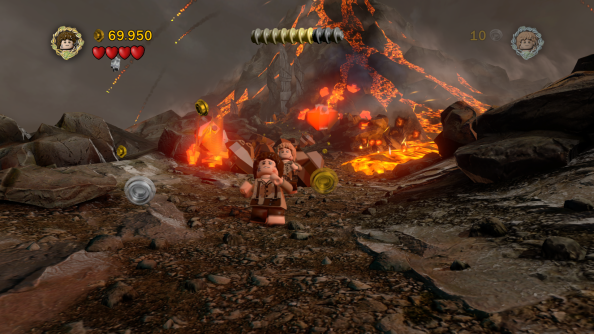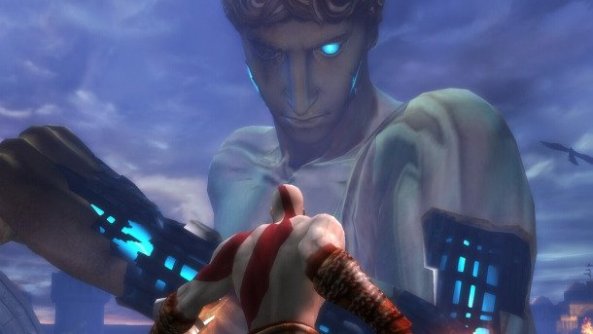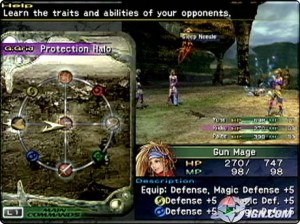
They’ve reigned in Legolas’ showboating. A little.
By now, these Lego game reviews are becoming somewhat of a crisis for me. What do I talk about? A licensed game? A corporate tie-in? A movie parody? A series of games so identical they make the Republican National Convention look like a celebration of diversity and globalism? A chance to play with Legos as a grown-up without having to worry about cleaning them up when I’m done? A series of relatively short games I can play when I need to write about something quickly? Probably a combination of all of those. The Lego Games are a lot like Will Ferrel DVDs in that respect—short, easy to get through, with a few humorous parts here and there, and something I’ll put on my shelf without looking at the extras and knowing that I’ll more likely than not never have the urge to come back to it.

Let’s mow down some motherfuckin’ orcs!
What then, if they adapted the best movie of all time? No, not Revenge of the Nerds IV. Not Ghostbusters either. Nope, not Cool Runnings. Or Back to the Future (although…). Or Star Wars…wait, yes on Star Wars, but no on this game. I’m talking about Peter Jackson’s epic take on J.R.R. Tolkien’s the Lord of the Rings, the beautiful modern-Medieval epic metaphor about the loss of our relationship with the natural world due to the effects of ambition, politics, and the desire for control over others. Yeah, it turns out it makes a pretty good game about plastic toy blocks.

So if the lava is 1300 degrees, how hot does the air have to be to melt plastic?
Lego games are starting to remind me of my time among in Korea. If you spend enough time with them and give them the proper attention, you start to wonder how people have trouble telling them apart. The earlier games were more combat-intensive, if you can consider a hunk of plastic the size of a ping-pong ball to be capable of combat. These games, most notably the Lego Star Wars games, had boss fights reminiscent of a poorly lubricated rock-em-sock-em robot set, whereas the boss fights became somewhat more complicated as the gameplay shifted more toward puzzle solving. At the extreme other end of the spectrum is Lego Jurassic World, a thrilling man-v-nature fight for survival against vicious predators in which the dinosaurs calmly stand by as you set up convoluted Rube Goldberg contraptions that will lead to their untimely re-extinction, sufficing to snarl kindly if you get off-track from your mission.

No, I am your father.
Lego Lord of the Rings meets these halfway, with perhaps a bit more emphasis on puzzle-solving than is healthy for a story that lists “Medieval Combat” at the top of its resume. Characters have skills and abilities which help you solve logical, intuitive puzzles such as catch-a-fish-to-throw-at-the-bird-to-distract-the-nazgul, catch-fish-to-throw-at-gollum-so-Sam-can-tie-the-rope-around-his-neck-so-Frodo-can-stab-him-with-Sting, and gather-fish-to-throw-at-the-wall-to-open-the-gate. And if you’re not into piscine-themed puzzles, enjoy such classics from the movie like Galadriel’s gift to Frodo. “I give you the light of Earendil, our most beloved star. May it be a light to you when quest items are hidden where other characters cannot access and need your help to get to.”

You know what protects your ring better than a smooth, unguarded pathway leading to a ledge over the only thing hot enough to destroy the One Ring? ANYTHING!
One think I thought novel of this game was that it told a more fluid rendition of its source material, rather than the Greatest Hits parade of other Lego games. You begin in the prologue, fighting against a Sauron that makes 300’s Xerxes look like a member of the Lollipop Guild. Once completed, you begin a long, arduous climb up Mt. Doom realizing that Sauron, the Ancient and Most Powerful of the Maiar, Lieutenant to Morgoth the Valar of All Things Corrupt, Fell or otherwise Evil, Etc, actually did very little to protect the One Weapon of All-Power and item that housed his mortal essence, and was easily outdone for security by a Dutch toy company. From there, each film seems to play about six levels to the usual five, and the traditional hub world for Lego games is replaced by a completely open map of Middle Earth that the player can travel to go from level to level, receive side quests, buy characters and items, and get completely turned around in despite the trail of phantom Lego studs leading you to your next destination. Levels are segmented and shorter than in other games, and often give you the choice between groups of characters, offering a timeline with a little more control and reason than the books give you.

That still only counts as one!
Puzzle-solving aspects alternate between the overly simplistic “stand here and push Z” (and during a handful of boss battles, just “stand here”) and “Throw fish at the wall to move forward,” which is about as intuitive as scraping a hedgehog across your keyboard to restart your computer. For those of you hoping for clunky, plastic Medieval warfare, there’s still a fair amount of that in the game, although it handles like old men swinging their walkers at each other, Legolas’ arrows have all the force behind them of an old Nerf dart blown out of the end of a wrapping-paper tube, and most of the battles come down to puzzle solving anyway. The humor starts out strong, but withers up like a dead orc near the end, and the game is riddled with glitches. So what reason, if any, remains to play the game?
It’s a scenery smasher. And in the end, don’t we all just want to hulk out and take revenge against all those Legos that refused to separate, even when we had the special separator tool? Take that, Lego environment! When I’m finished with you, you’re going to wish Climate Change had gotten to you first!











